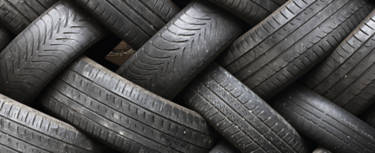Common Tire Wear Conditions and Their Causes
The fact is, while some tires are built for longevity and others are built for performance – the old saying that "the tire that performs twice as well lasts half as long" is often still true.
On top of that, there are dozens of ways your tires can deteriorate over time beyond simply wearing down through normal driving.
But don’t worry! We put together this list so you can identify how your tires are wearing down and how you can help them last longer, if possible.
Tire Wear Conditions
Alignment wear
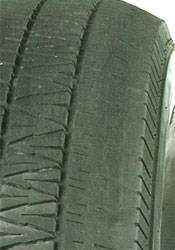
Possible Cause: Vehicle misalignment
Solution: Depending on the severity, your affected tires may need to be replaced.
Tire wear caused by poor wheel alignment typically shows up in the form of heavy wear on the tire's inner or outer edges, as pictured here. A slight misalignment can cause havoc on your tires and should be corrected right away to prevent this form of tire wear.
Underinflated tires
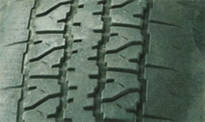
Possible Cause: Low tire pressure, potentially from a puncture
Solution: Inflate the affected tires to the proper air pressure. Depending on how severe the wear is, they may need to be replaced.
When a tire is underinflated, the weight shifts to the firmest part of the tire, which is the sidewall. That's why you see extreme wear on both outer shoulders.
It's best to check your tire air pressure at least once a month, and before long road trips. You can always stop by any of our locations for a free tire air pressure check.
Center of tire wear
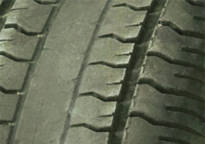
Possible Cause: Overinflation
Solution: Adjust the air pressure to the manufacturer recommended specs. Depending on the severity of wear, you may need to replace your impacted tires.
The center wear pattern pictured here shows the effect of overinflation. You'll notice the center of the tread is wearing faster than the rest of the tread. This is just one of many reasons that having the proper air pressure is so vital. Always be sure to set your tires to the manufacturer recommended air pressure. This will help you get the best performance out of your tires for as long as possible.
Flat spots on tires
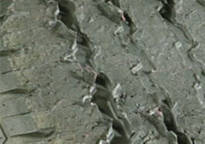
Possible Causes: Brakes locking up or tires skidding
Solution: Depending on the severity, replacement may be your best bet.
As pictured here, the tread has a flat spot across the width of the tread where the tire made contact with the road surface and wore down in one specific spot. Thanks to anti-lock brakes, tire flat spots aren't as common as they once were.
Another possible cause of flat spots is long-term vehicle storage or leaving your vehicle parked for an extended period of time.
While not as severe as flat spots caused by locked brakes, this type of flat spot can still cause ride comfort issues. If you're planning on storing your vehicle for an extended period of time, placing the vehicle on jack stands will ease the load and prevent flat spots from forming.
Irregular tire wear
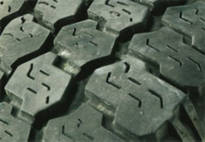
Possible Cause: Tire belt separation, worn suspension or lack of tire rotations
Solution: Depending on the severity, your tires may need to be replaced, particularly if belt separation is the cause.
Sometimes called feathering, irregular tire wear like this can be caused by tread separation, worn suspension or a lack of tire rotations.
A tire belt separation is the result of the belt plies in the inner liner of the tire separating from each other and sometimes allowing air to permeate into that open space. If unattended, a belt separation can result in tire failure.
Another cause of the irregular tire wear can be worn suspension. Worn suspension can cause the vehicle to potentially bounce or develop unexpected motions that the tires are not designed to handle. If you notice irregular tire wear, bring your tires in for an inspection ASAP, so we can diagnose the cause immediately.
Common Tire Tread Conditions
There are thousands of tire tread designs and patterns, all with different features and purposes. Though they can wear down at different intervals and from different causes, you can find some of the more common tire tread conditions below.
Exposed tire cords
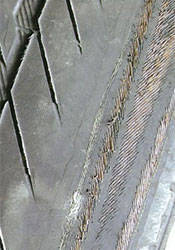
Possible Causes: Underinflation, misalignment or vehicle suspension
Solution: For safety concerns, we recommend immediate replacement.
Exposed tire cords can be the result of a few different things like underinflation, misalignment or worn suspension. As pictured here, the result is extreme premature wear on the edge of the tire that has exposed the inner cord layer.
Once the cords are exposed, your tires aren't safe to drive on and should be replaced immediately.
Tire impact break
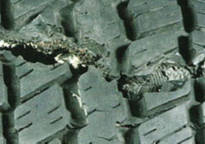
Possible Cause: Impact with an object or debris while driving Solution: For safety concerns, we recommend immediate replacement.
A tire impact break can sometimes be difficult to spot. As pictured here, breaks like these are often caused by hitting an object in the road like a pothole, bump, foreign object or blunt item.
As tires have evolved, reinforced sidewalls and stronger plies have been put in place to try to defend the tire from this damage, but it can still happen. If you hit any debris in the road, it's a good idea to have your tires inspected straightaway for impact breaks.
If you've accidentally run over any pot holes or road debris, it's also a good idea to give your rims a once over. If debris has caused damage to your tires, it may have also bent or even cracked your rims.
Luckily, we've got a huge assortment of replacement rims, so we can get you back on the road safely and in style.
Tire chunking
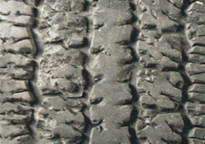
Possible Cause: Most frequently encountered on tires that are used off the pavement for extended periods of time
Solution: Depending on the severity, replacement may be necessary.
Tire chunking is typically the direct result of frequent driving off-road or on unpaved/ gravel roads. These rougher surfaces eventually break down the tread blocks and cause pieces of the tire tread to be ripped off or worn away.
Tire chunking can also occur when an off-road or mud tire is used on the highway for an extended period of time. Designed to handle rugged off-road terrains, these tires have large voids and tread blocks that can break down on the highway.
Tire belt separation

Possible Causes: Manufacturer defect, improper inflation or overloaded vehicle
Solution: Tread separation is a very dangerous condition, and the affected tire should be replaced ASAP.
Tread separation is often the result of a manufacturer defect. In this case, we can usually return these tires under the terms of any existing tire warranty.
That said, thanks to advancements in tire technology, a tire belt separation is not as common under normal driving conditions. Separations typically occur when the tire is overloaded or underinflated. Overloading/underinflation cause extreme heat build-up in the tire, which can cause tire failure. That's just one more reason to make air checks a part of your regular vehicle maintenance.
Tire tread splice
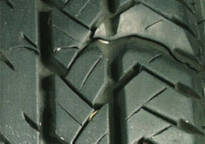
Possible Cause: Underinflation and overloading
Solution: A tread splice is very dangerous. Tires with this tread condition should be taken out of service right away.
Tread splices can be caused by low air pressure and tire overloading. Excessive heat buildup caused by underinflation/overloading makes the tire more vulnerable to damage, making it possible for even the slightest bump in the road to splice the tread.
A tire splice can also be the result of a defect in the manufacturing process, in which case, the tire should be replaceable under any applicable tire warranty.
Common Ture Shoulder and Sidewall Conditions
Tire sidewalls and shoulders effectively do exactly what they sound like they might: provide sturdy support for your vehicle’s weight as they shoulder the force and momentum of your vehicle through turns, acceleration and stopping.
Because they play such a vital role in tire performance, any issues with your tire shoulders and sidewalls can be quite serious. We highly recommend routine tire inspections to check your tires for the following shoulder and sidewall conditions:
Sidewall impact break
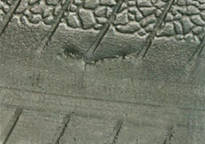
Possible Causes: Striking an object or going over a curb, especially at high speeds
Solution: For safety concerns, we recommend immediate replacement.
A sidewall impact break is the result of hitting an object in the road and causing internal sidewall damage. This can be difficult to detect from the outside of the tire and may require a tire professional to remove the tire from the rim and inspect the inner liner of the tire, as pictured here.
Even the smallest damage to the sidewall or inner line weakens the structural integrity of the tire, making replacement an absolute necessity.
Ozone cracking/tire dry rot
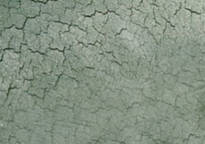
Possible Cause: Prolonged exposure to direct sunlight and high temperatures
Solution: Depending on how severe the dry rot is, your tires may need to be replaced. Luckily, this condition is often covered by your manufacturer warranty, if the date code doesn't exceed the manufacturer's requirements.
Ozone cracking and dry rot can be very common in hot and dry climates. The natural oils in the rubber dry out over time and can cause small cracks in the tread and sidewall as pictured here. Ozone cracking and dry rot can be cause for replacement.
Tires should be replaced every six years regardless of mileage or tread depth, and should be removed from service after 10 years.
Heat ring
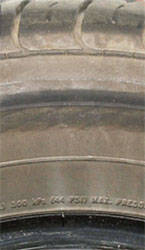
Possible Cause: Excessive load being carried or driving on a flat tire
Solution: For safety concerns, we recommend immediate replacement.
A heat ring is typically the result of extended use of a tire while it is severely underinflated. When viewing the sidewall from the outside of the tire, a heat ring can be subtle or more pronounced, depending on the amount of damage.
If you've had to drive on your tire while deflated, we'd recommend having your tires inspected immediately, as the tire will need to be removed from the rim so the damage can be assessed.
In some cases, the internal damage can be quite serious and may require replacement as soon as possible. But if your tires are covered by our Certificates, this damage will be covered.
Tire sidewall blister
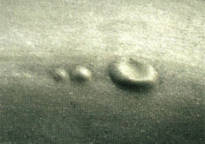
Possible Cause: Underinflation or exceeding the tire's carrying capacity
Solution: This could be a defect in the manufacturing process. We can usually return these tires under the terms of any existing tire warranty.
One of the more uncommon sidewall issues, sidewall blisters are usually only noticeable from the inside of the tire, as pictured here. During a professional tire inspection, we can inspect the inner liner of the tire. To avoid sidewall blisters, be sure to check your tire air pressure at least once a month.
Sidewall bulge
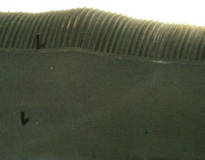
Possible Cause: Impact with an object in the road
Solution: Tires with a sidewall bulge, AKA an impact bubble, should be replaced right away.
A sidewall bulge is the result of an impact with an object in the road, or even hitting a curb. This impact separates the sidewall plies and allows air to escape the inner liner, creating a bulge in the tire, as pictured here. There is no way to safely repair this or any sidewall damage, and their tire will need immediate replacement.
Sidewall splice

Possible Cause: Underinflation and overloading
Solution: This could be a defect in the manufacturing process. We can usually return these tires under the terms of any existing tire warranty.
A sidewall splice is the result of low tire pressure and excessive weight causing the tire to be overloaded. The splice in the sidewall typically starts small and gets bigger as heat builds up. A sidewall splice will eventually result in tire failure and should be replaced right away.
Torque cracks
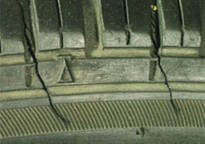
Possible Cause: Massive amounts of torque from high-performance or heavy-duty vehicles towing a load
Solution: If not caused by intentional abuse, this could be a defect in the manufacturing process. We can usually return these tires under the terms of any existing tire warranty.
Torque cracks are the result of extreme torque being placed on the tire sidewall from high horsepower or heavy duty low end power. Typically you can find multiple torque cracks circling the sidewall. Torque cracks will eventually result in tire failure and should be replaced right away.
If any of these tire wear patterns look or sound familiar, simply swing by one of our locations.
We can show you how to check tire tread, diagnose tire damage and take care of the warranty process for you. Regular tire maintenance can help avoid some of these tire wear patterns and detect any issues before tire failure.
